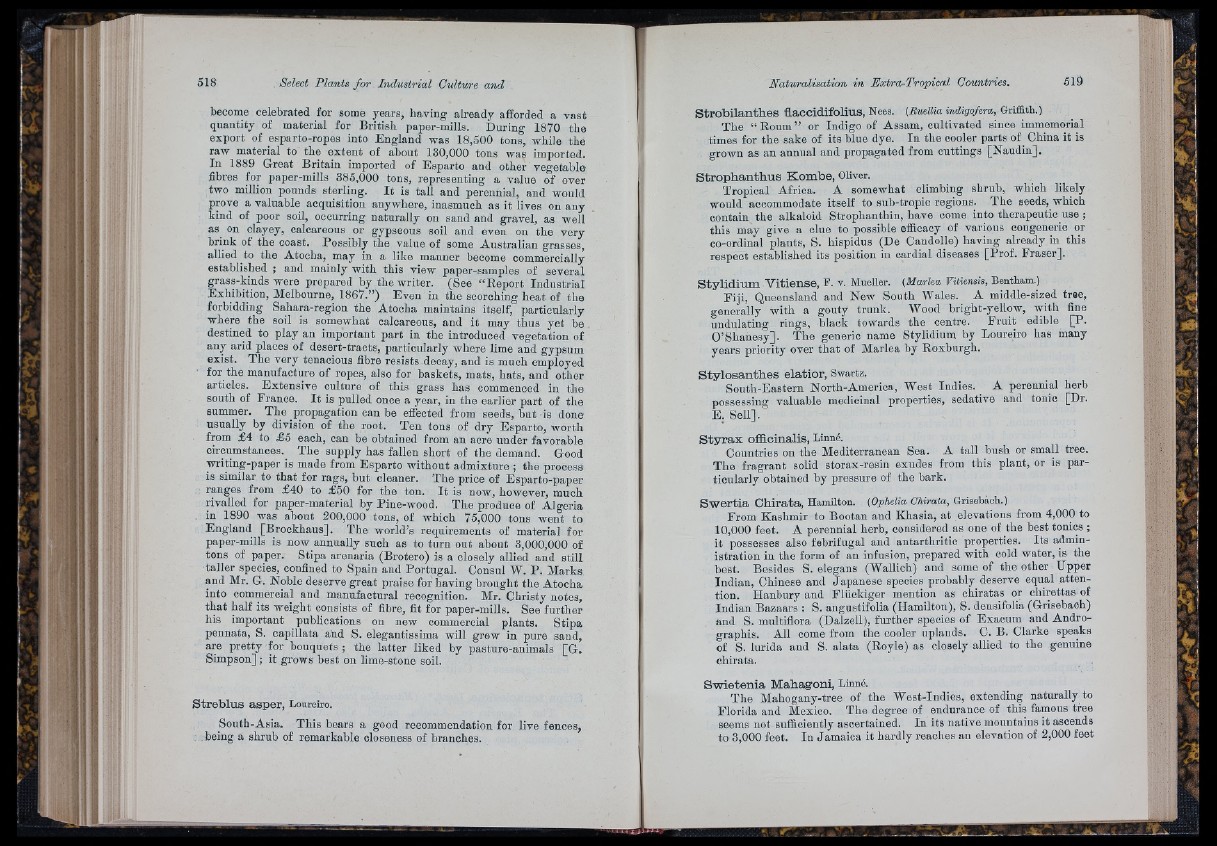
become celebrated for some years, having already afiorded a vast
quantity of material for British paper-mills. During 1870 the
export of esparto-ropes into England was 18,500 tons, while the
raw material to the extent of about 130,000 tons was imported.
In 1889 Great Britain imported of Esparto and other vegetable
fibres for paper-mills 385,000 tons, representing a value of over
two million pounds sterling. I t is tall and perennial, and would
prove a valuable acquisition anywhere, inasmuch as it lives on any
kind of poor soil, occurring naturally on sand and gravel, as well
as^ on clayey, calcareous or gypseous soil and even on th e very
brink of the coast. Possibly the value of some Australian grasses,
allied to the Atocha, may in a like manner become commercially
established ; and mainly with this view paper-samples of several
grass-kiuds were prepared by the writer. (See “ Report Industrial
Exhibition, Melbourne, 1867.”) Even in the scorching heat of the
forbidding Sahara-region the Atocha maintains itself, particularly
where the soil is somewhat calcareous, and it may thus yet be
destined to play an important part in the introduced vegetation of
any arid places of desert-tracts, particularly where lime and gypsum
exist. The very tenacious fibre resists decay, and is much employed
for the manufacture of ropes, also for baskets, mats, hats, and other
articles. Extensive culture of this grass has commenced in the
south of France. I t is pulled once a year, in the earlier part of the
summer. The propagation can be effected from seeds, hut is done
usually by division of the root. Ten tons of dry Esparto, worth
from £ 4 to £ 5 each, can be obtained from an acre under favorable
ciroumstances._ The supply has fallen short of the demand. Good
writing-paper is made from Esparto without admixture ; the process
is similar to th a t for rags, but cleaner. The price of Esparto-paper
ranges from £40 to £50 for the ton. I t is now, however, much
rivalled for paper-material by Pine-wood. The produce of Algeria
in 1890 was about 200,000 tons, of which 75,000 tons went to
England [Brockhaus]. The world’s requirements of material for
paper-mills is now annually such as to turn out about 3,000,000 of
tons of paper. Stipa arenaria (Brotero) is a closely allied and still
■taller species, confined to Spain and Portugal. Consul W. P. Marks
and Mr. G. Noble deserve great praise for having brought the Atocha
into commercial and manufactnral recognition. Mr. Christy notes,
that half its weight consists of fibre, fit for paper-mills. See further
his important puhKcations on new commercial plants. Stipa
pennata, S. capillata and S. elegantissima will grow in pure sand,
are pretty for bouquets ; the latter liked by pasture-animals [G.
Simpson]; it grows best on lime-stone soil.
S t r e b lu s a s p e r , Loureiro.
South-Asia. This hears a good recommendation for live fences,
being a shrub of remarkable closeness of branches.
S t r o b i l a n t h e s ■fiaccidifolius, Nees. {SuelUa indigofera, Griffith.)
The “ Eoum ” or Indigo of Assam, cultivated since immemorial
times for the sake of its blue dye. In the cooler parts of China it is
grown as an annual and propagated from cuttings [Naudin].
S t r o p h a n t h u s K om b e , Oliver.
Tropical Africa. A somewhat climbing shrub, which likely
would accommodate itself to sub-tropic regions. The seeds, which
contain the alkaloid Strophanthin, have come into therapeutic use ;
this may give a clue to possible efficacy of various congeneric or
co-ordinal plants, S. hispidus (De Candolle) having already in this
respect established its position in cardial diseases [Prof. Fraser].
s t y l i d i u m V i tie n s e , P. V. Mueller. (Marlea Vitiensis, Bentham.)
Fiji, Queensland and New South Wales. A middle-sized tree,
generally with a gouty trunk. Wood bright-yellow, with fine
undulating rings, black towards the centre. Fru it edible [P.
O’Shanesy]. The generic name Stylidium by Loureiro has many
years priority over th a t of Marlea by Roxburgh.
S t y l o s a n th e s e la tio r , Swartz.
South-Eastern North-America, West Indies. A perennial herb
possessing valnable medioinal properties, sedative and tonic [Dr.
E_. Sell].
S t y r a x o fflc in a lis , Linné.
Countries on the Mediterranean Sea. A tall bush or small tree.
The fragrant solid storax-resin exudes from this plant, or is particularly
obtained by pressure of the bark.
S 'w e r t i a C b ir a ta , Hamilton. [Ophelia Ohirata, Grisebach.)
From Kashmir to Bootan and Khasia, at elevations from 4,000 to
10,000 feet. A perennial herb, considered as one of the best tonics ;
it possesses also febrifugal and antarthritic properties. Its administration
in the form of an infusion, prepared with cold water, is the
best. Besides S. elegans (Wallich) and some of the other Upper
Indian, Chinese and Japanese species probably deserve equal attention.
Hanbury and Fliickiger mention as chiratas or chirettas of
Indian Bazaars ; S. angustifolia (Hamilton), S. densifolia (Grisebach)
and S. multiflora (Dalzell), further species of Exacum and Andro-
graphis. All come from the cooler uplands. C. B. Clarke speaks
of S. iurida and S. alata (Royle) as closely allied to the genuine
chirata.
S w i e t e n i a M a h a g o n i, Linné.
The Mahogany-tree of the West-Indies, extending naturally to
Florida and Mexico. The degree of endurance of this famous tree
seems not sufficiently ascertained. In its native mountains it ascends
to 3,000 feet. In Jamaica it hardly reaches an elevation of 2,000 feet